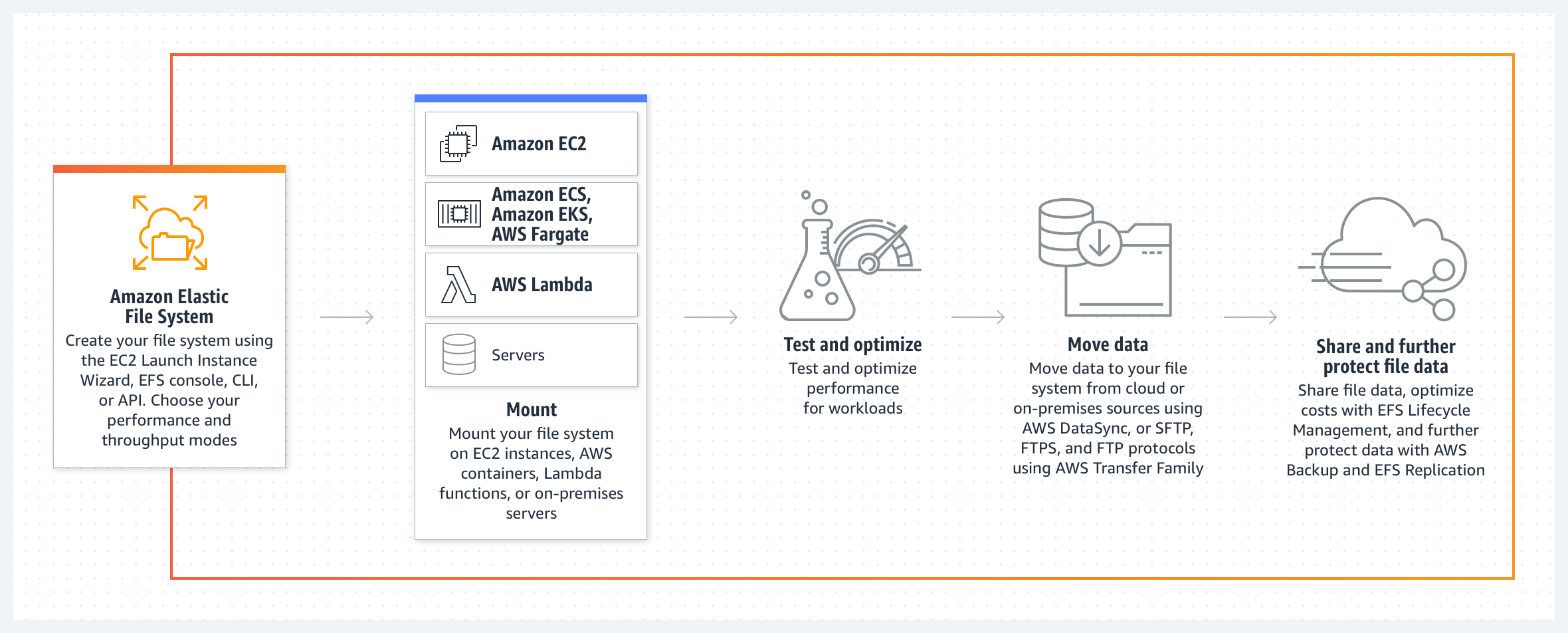Amazon Web Services (AWS) offers a range of storage options for its users, including Amazon Elastic Block Store (EBS), Amazon Elastic File System (EFS), and Amazon Simple Storage Service (S3). These services are designed to meet different storage needs and have their own unique features, advantages, and use cases.
It is essential to understand the differences between these services to choose the right one for your needs. Choosing the wrong service can lead to unnecessary costs, poor performance, and inadequate storage capacity.
Amazon EBS is a block storage service that provides persistent, high-performance storage volumes for use with Amazon EC2 instances. It is ideal for applications that require low-latency and high-throughput storage, such as databases and transactional workloads.
Amazon EFS, on the other hand, is a fully-managed file storage service that is designed to provide scalable, shared access to files for multiple EC2 instances. It is ideal for workloads that require shared file access and supports NFSv4 and NFSv4.1 protocols.
Amazon S3 is a highly-scalable, durable, and secure object storage service that is designed for storing and retrieving any amount of data from anywhere in the world. It is ideal for a wide range of use cases, including backup and restore content storage and distribution, and big data analytics.
Understanding the differences between these services and their use cases is crucial to selecting the right service for your needs. It will help you avoid unnecessary costs, reduce complexity, and ensure optimal performance and scalability for your applications.
Amazon Elastic Block Store (Amazon EBS)
Amazon EBS can be used to provide storage for your virtual machine drives. It organizes data into a hierarchy similar to a traditional file system by storing it in equal-sized blocks. Volumes are provisioned in size and attached to EC2 instances like a physical machine’s local disk drive. Here are some of the advantages and applications of EBS:

Amazon EBS Advantages
- Increase throughput by allocating network capacity and minimizing network contention between your instances and EBS.
- Low-latency performance: By utilizing SSD EBS volumes, it provides dependable I/O performance that can be scaled to meet your workload requirements. If your application requires a high performance but not a large amount of storage, you can separate performance from storage capacity.
- Storage that is highly available and secure: EBS volumes provide redundancy within its Availability Zones, while access control and encryption improve security.
- Geographic interchangeability: You can duplicate snapshots across AWS regions and place resources and data in multiple locations using EBS. Disaster recovery, data center migration, and geographical expansion are all made easier as a result of this.
- Data backup and restoration are simple: point-in-time volume snapshots protect data.
- Rapid volume scaling: EBS can quickly scale volumes, ensuring that you get the right performance and capacity for changing computing needs.
- Possible cost savings: Although you must pre-allocate your entire disk, EBS costs about a third as much as EFS per GB if you know how much space you need and only access your storage from one EC2 instance at a time.
Use Cases
- Scaling, archiving, duplicating, or provisioning your testing, development, or production environments are all options.
- NoSQL databases: EBS provides the low-latency performance and dependability that NoSQL databases require for peak performance.
- Relational databases: EBS can be scaled to meet your changing storage requirements. As a result, it is an excellent choice for deploying databases such as PostgreSQL, MySQL, Oracle, and Microsoft SQL Server.
- Copy EBS Snapshots and Amazon Machine Images (AMIs) to run applications in different AWS regions for business consistency. Regularly backing up log files and data across geographies, reduces data loss and speeds up recovery time.
- Enterprise-wide applications: It can meet a wide range of enterprise computing requirements by providing powerful block storage that can support your most critical applications, such as Microsoft Exchange and Oracle.
Amazon Elastic File System (Amazon EFS)
Amazon Elastic File System (Amazon EFS) EFS is the best choice for running any application that requires scalable storage and must produce output quickly. It scales automatically, even in the face of sudden workload spikes. EFS will automatically scale back down after the period of high-volume storage demand has passed. EFS can be mounted on various AWS services and accessed by all of your virtual machines. It can be used to run shared volumes or for big data analysis. You’ll always pay for the storage you use, rather than pre-provisioning storage that could be wasted.

Amazon EFS Advantages
- Scalable performance to support any workload: EFS provides the throughput that changing workloads require. It can deliver higher throughput in bursts that correspond to sudden file system growth, even for workloads of up to 500,000 IOPS or 10 GB per second.
- Energetic elasticity: Scale your file system storage up or down automatically. Never remove or add files, and never interfere with applications. Once your EFS file system is created, you can add files without worrying about storage provisioning.
- File storage that is accessible: On-premises servers and EC2 instances can both access shared file systems at the same time. Through VPC peering, EC2 instances can also access EFS file systems in other AWS regions.
- Support for serverless architecture: Unlike EBS, EFS works with AWS Lambda serverless functions to easily share data between functions. Lambda functions can read large files, such as code libraries, from EFS and write output to EFS for storage and sharing.
Also,
- EFS is a fully managed service, which means your company will never have to patch, deploy, or maintain your file system.
- Cost savings: Because there is no advance provisioning, up-front fees, or commitments, you will only pay for what you use. Furthermore, you can use Lifecycle Management to move files that have been inactive for a month to a more cost-effective storage class, which can reduce costs by up to 85 percent. However, keep in mind that EFS is roughly three times as expensive.
- Tighter security and compliance: You can use your current security solution to securely access the file system, or you can control access to EFS file systems using AWS Identity and Access Management (IAM), Amazon Virtual Private Cloud (Amazon VPC), or POSIX permissions. Furthermore, EFS can encrypt your data while it is in transit or at rest. This provides dependable security and simplifies regulatory compliance.
Use Cases
- Support for lift-and-shift applications: EFS is pliable, accessible, and scalable. It enables you to easily and quickly migrate enterprise applications without having to re-architect them.
- Analytics for big data: It can run big data applications that require high node throughput, low-latency file access, and read-after-write operations.
- Support for content management systems and web servers: EFS is a high-throughput file system that can run content management systems and web-serving applications such as archives, websites, and blogs.
- Only EFS provides the shared file system required to share code and files across multiple compute resources to enable auto-scaling workloads.
Amazon S3
Amazon S3 is a service that allows you to store objects. Each object has its unique identifier or key, which allows it to be accessed via web requests from any location. S3 also allows for the hosting of static web content, which can be accessed via the S3 bucket or AWS CloudFront. And S3 is exceptionally secure, with “eleven nines” — 99.999999999 of data durability.

Advantages of Amazon S3
- Exceptional performance, scalability, and availability: Amazon S3 scales storage resources without requiring resource procurement cycles or upfront investments. It safeguards your data against errors, failures, and threats. It ensures that it is available when you need it.
- Storage classes that save money: Storing data across S3 storage classes save money while maintaining high levels of performance. You can use storage class analysis to find data that can be moved to a lower-cost storage class. Then, using an S3 Lifecycle policy, you can perform the transfer. Finally, S3 Intelligent-Tiering allows for the storage of data with changing or unknown access patterns by tiering objects, lowering storage costs.
- S3 can store data and protect it from unauthorized access using its powerful access management and encryption tools, making security, compliance, and auditing easier. S3 includes features that make it simple to meet regulatory requirements, and Amazon Macie can deny unauthorized access to your sensitive data. Furthermore, S3 integrates well with AWS’ extensive auditing capabilities.
- Exact data control: You can classify and report on data using a variety of management tools. S3 has storage class analysis, which monitors access patterns, and S3 Lifecycle, which analyzes object transfers to less expensive storage. S3 Object Lock assigns retention dates to objects to prevent deletion, and S3 Inventory provides visibility into stored objects as well as their encryption and metadata.
Use Cases
- S3 can create a data lake to hold raw data in its native format, and then use machine learning tools, query-in-place, and analytics to draw insights. S3 collaborates with AWS Lake Formation to create data lakes, after which governance, security, and auditing policies are defined. They can be scaled together to meet your growing data stores, and you’ll never have to make an upfront investment.
- Backup and restoration: When you combine S3 with other AWS offerings like EBS, EFS, or S3 Glacier, you can easily build secure, robust backup and restoration solutions. These offerings improve your on-premises capabilities, while others can assist you in meeting compliance, recovery time, and recovery point goals.
- Reliable disaster recovery: S3 storage, S3 Cross-Region Replication, and other AWS networking, computing, and database services make it simple to safeguard critical applications, data, and IT systems. It provides quick recovery from outages caused by system failures, natural disasters, or human error.
- Methodical archiving: S3 integrates with other AWS services to provide methodical archiving. You can archive data and retire physical infrastructure with S3 Glacier and S3 Glacier Deep Archive. You can use three S3 storage classes to keep objects at their lowest rates for extended periods. S3 Lifecycle policies can be created to archive objects at any point in their lifecycle, or objects can be directly uploaded to archival storage classes.
Hurry up and try the free practice tests offered by Testpreptraining.com!
Comparing Amazon EBS, EFS, and S3
Here is a comparison of Amazon EBS, EFS, and S3 in terms of features and pricing:
- Features:
- Amazon EBS: It provides persistent block-level storage volumes that can be attached to Amazon EC2 instances. It is designed for low-latency, transactional workloads and is suitable for running databases, enterprise applications, and other I/O-intensive workloads. It offers features like encryption, snapshots, and point-in-time recovery.
- Amazon EFS: It is a fully-managed, scalable network file system that can be accessed from multiple EC2 instances simultaneously. It is suitable for applications that require shared file access, such as content management systems, web serving, and data analytics workloads. It offers features like encryption, automatic scaling, and lifecycle management.
- Amazon S3: It is designed for object storage and retrieval and is suitable for storing large amounts of unstructured data such as photos, videos, and documents, as well as hosting static websites. It offers features like encryption, versioning, lifecycle policies, and access control.
- Pricing:
- Amazon EBS: It is priced based on the size and type of the volume, and the amount of data transferred in and out of the volume. There are four types of volumes available: General Purpose SSD, Provisioned IOPS SSD, Throughput Optimized HDD, and Cold HDD.
- Amazon EFS: It is priced based on the amount of data stored and the amount of data transferred in and out of the file system. There are two performance modes available: General Purpose and Max I/O.
- Amazon S3: It is priced based on the amount of data stored, the number of requests made, and the amount of data transferred in and out of the storage. There are different storage classes available, such as Standard, Infrequent Access, and Glacier, each with different pricing.

